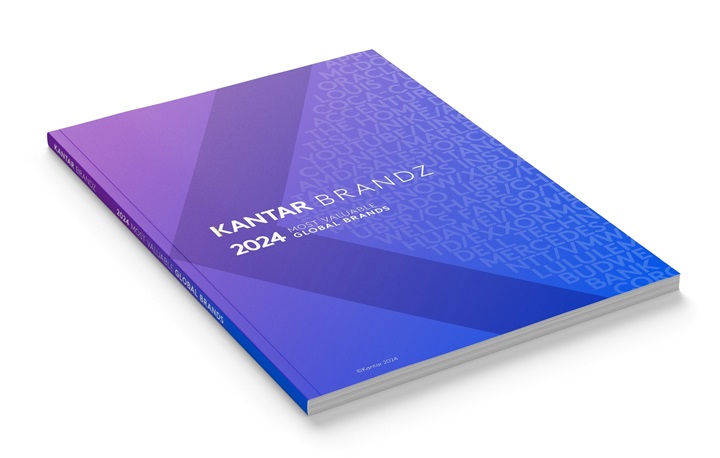The total value of the Top 100 Chinese brands now stands at $968 billion, according to the new 2024 Kantar BrandZ Most Valuable Chinese Brands Report released today. Launched at this year’s Kantar BrandZ China Gala Event in Shanghai, under the theme Shape Your Brand Future, Accelerate Brand Growth, the value of China’s Top 100 shows a slight decrease of 4% compared to last year. After two consecutive years of double-digit declines, China’s brand value is beginning to recover, indicating that Chinese brands are once again able to see the potential for growth.
The Top 10 Most Valuable Chinese Brands of the Year
Tencent retains the top spot for the fourth year running with a total value of $129 billion. One of the most consistent performers in the ranking, it has successfully found new spaces for growth, and now derives its brand value from both the Media and Entertainment and Business Technology and Services Platforms categories. Kantar’s breakthrough strategic framework, The Blueprint for Brand Growth, shows that brands grow by being Meaningfully Different, able to build deeper and broader connections with consumers over time, and by predisposing themselves to more people, being more present, and finding new spaces for growth.
Alcohol brand, Moutai moves into second position in the Chinese brand ranking, with a brand value of $87.3bn, followed by Alibaba (No.3; $68.5bn) and Douyin (No.4; $56.9bn) in fourth place. Huawei (No.5; $41bn) rejoins the Top 5, claiming the title of this year’s Top Riser with an impressive 52% year-on-year growth and an innovation-led turnaround that includes its thriving cloud and digital businesses.
Kantar BrandZ Top 10 Most Valuable Chinese Brands 2024
| Rank | Brand | Category | Brand Value 2024 (US$ M) |
| 1 | Tencent | Media and Entertainment/Business Technology and Services Platforms | 129,039 |
| 2 | Moutai | Alcohol | 87,298 |
| 3 | Alibaba | Retail | 68,482 |
| 4 | Douyin | Media and Entertainment | 56,882 |
| 5 | Huawei | Consumer Technology and Services Platforms | 41,039 |
| 6 | China Mobile | Telecom Providers | 35,276 |
| 7 | Haier | IoT Ecosystem | 32,414 |
| 8 | ICBC | Financial Services | 28,521 |
| 9 | Ping An | Financial Services | 20,514 |
| 10 | Pinduoduo | Retail | 20,257 |
We firmly believe that in both prosperous and challenging times, building strong, Meaningful and Different brands will inevitably yield rewards. Chinese companies are striving to overcome the challenges of growing from being excellent to becoming extraordinary. Consumers are eager for fresh experiences and healthier lifestyles. Brands can find new opportunities for growth by investing in new product innovation, new moments, new groups, new regions and new channels. Kantar’s Blueprint for Brand Growth can help enable this. By implementing meaningful new strategies and innovative approaches, companies can drive market penetration, achieving over five times that of ordinary brands. Regardless of budget constraints, Chinese brands must continue to invest in brand building.
Newcomers, Re-entries and Top Risers
Nine brands enter the China Top 100 this year, either as newcomers or re-entrants. The highest-ranking new entrant is vivo (No.34; $5.4bn). Guided by the principles of “user-centricity”, “pursuit of excellence”, and “accessible technology”, vivo has launched its technology brand ‘Blue Technology’ and continues to leverage its deep technical expertise in areas such as design, imaging, systems and performance to create a future where technology and everyday life are seamlessly integrated for consumers. With its turnaround to profitability and solid brand foundation, DiDi Chuxing (No.47; $3.7bn) becomes the highest-ranking returning brand this year.
Newcomers and Re-entries
| Rank | Brand | Category | Brand Value 2024 (US$ M) | New/Re-entry |
| 34 | vivo | Consumer Technology and Services Platforms | 5,375 | New |
| 47 | Didi Chuxing | Consumer Technology and Services Platforms | 3,713 | Re-entry |
| 72 | Boss Zhipin | Consumer Technology and Services Platforms | 2,251 | New |
| 91 | Bank of Ningbo | Financial Services | 1,491 | New |
| 94 | Vip.com | Retail | 1,332 | Re-entry |
| 95 | Ximalaya | Media and Entertainment | 1,331 | New |
| 97 | Hainan Airlines | Travel Services | 1,321 | Re-entry |
| 98 | HAVAL | Automotive | 1,309 | Re-entry |
| 99 | Kugou | Media and Entertainment | 1,290 | New |
China’s brand ranking includes 36 brands that have grown value year-on-year, 11 of which have grown by 20% or more. The top three fastest risers include Huawei (+52%), NetEase (No.25; +51%) and Pinduoduo (No.10; +47%).
Top 10 Risers
| Rank | Brand | Category | Brand Value 2024 (US$ M) | Brand Value Change 2024 vs. 2023 |
| 5 | Huawei | Consumer Technology and Services Platforms | 41,039 | 52% |
| 25 | NetEase | Media and Entertainment | 8,775 | 51% |
| 10 | Pinduoduo | Retail | 20,257 | 47% |
| 11 | Agricultural Bank of China | Financial Services | 19,615 | 32% |
| 28 | CNPC | Energy | 8,436 | 29% |
| 18 | Bank of China | Financial Services | 14,236 | 24% |
| 67 | Luckin Coffee | Fast Food | 2,517 | 24% |
| 22 | Sinopec | Energy | 10,390 | 22% |
| 65 | PICC | Financial Services | 2,563 | 22% |
| 4 | Douyin | Media and Entertainment | 56,882 | 22% |
Commenting on this year’s results, my colleague, Sirius Wang, Managing Director of Product & Operations, Kantar Greater China, adds: “Throughout this year’s report, buzzwords like innovation and artificial intelligence frequently appear, driving the positive and stable development of Chinese brands. In fact, the rise of AI and other technologies has been a catalyst for the evolution of global business models, with China already demonstrating remarkable strength in this field. For example, iFLYTEK (No.39; $4.7bn) has introduced the Spark Model, the first large language model in China trained on a fully domestically developed computing power platform, ensuring complete autonomy and control.”
He also shared: “Kantar has significantly accelerated its exploration and deployment in the AI field this year. We have upgraded several AI-powered insight tools and launched the KMP.AI content insight service in the Chinese market, based on artificial intelligence large models. This is an unparalleled innovation in the industry.”
Industry Highlights and Trends
This year’s Top 100 Chinese Brands come from across 21 categories*. Media and Entertainment is once again the largest category by total brand value with 13 brands making the list. Combined, brands from the Media and Entertainment, Retail, Financial Services and Alcohol categories account for nearly two-thirds of the total value of China’s Top 100.
Among them, social media and ecommerce brand, Xiaohongshu (No.31; $7.3bn) is known for capturing emotional value. With its continuous stream of products and trending topics, Xiaohongshu’s recommendations not only enhance brand goodwill and trust, but also create broader commercial influence. Overall, Chinese brands’ content-driven e-commerce strategies lead globally, deeply integrated into every aspect of consumers’ daily lives. Xiaohongshu’s brand value growth has benefited from this.
Lenovo (No.45; $3.8bn), a consumer technology and services platform, jumped nine places in this year’s brand ranking, driven by its outstanding performance in the wave of globalisation. Meanwhile, BYD (No.24; $9.6bn) continues to maintain its position as an industry leader. Helping China to become the world’s largest car exporter, the electric vehicle manufacturer is also actively expanding into global markets.
Lynn Zhang, Managing Director of Innovation & Customer Experience, Kantar China also shared her perspective on the results: “Chinese enterprises are driving innovation to create powerful national brands with a global perspective, striving to establish themselves at the mid-to-high end of the global industrial chain. From the initial wave of Chinese brands that ventured overseas predominantly from the 3C industry (Computer, Communications and Consumer Electronics) and from technology sectors to the present day’s automotive, media and entertainment industries, an increasing number of Chinese brands have become some of the most iconic global names. A notable example is TCL (No.77; $2.1bn) which has embarked on a 25-year journey towards globalisation. Since entering the Vietnamese market in 1999 to initiate its global development, TCL has consistently pursued product and technological innovation, adhered to localised operations overseas and driven continuous growth in international revenue, all while creating personalised and intelligent user experiences.”
Other findings from the Kantar BrandZ Most Valuable Chinese Brands Report include:
- The pursuit of Meaningful Difference: Two-thirds of the most valuable Chinese brands are highly Meaningful and Different in consumers’ eyes. Attaining Meaningful Difference is the crucial first step in predisposing more people to buy and pay more for a brand’s offerings. The challenge ahead for most Chinese brands will be to continue to grow their Meaningful and Different perceptions in tandem, rather than focusing on one attribute or the other.
- The strategy of accelerating globalisation: Overseas expansion is a key growth strategy for many Chinese brands demonstrated by the success of Huawei, Douyin and Haier (No.7; $32.4bn). Chinese brands should work to surface actionable insights around overseas consumers that may differ in their needs and wants. In the long run, overseas offices and R&D centres can help to accomplish this goal, as well as AI testing tools and consumer trackers.
- Setting a rational pricing matrix: Brands should set both short-term and long-term pricing goals for their products and adjust prices flexibly to align with consumer perceptions of value. Over-emphasising low prices can damage brand value and ultimately lead to unprofitability. Currently, most of China’s Top 100 brands are positioned in the mid-price range, with potential for premiumisation. Brands can use a diverse media mix to maintain a strong market presence, enhancing brand recognition and encouraging consumers to willingly pay for high-value products or services. At the same time, many households are shifting towards more cost-effective and practical products, driving the rise of hard discount retailers. Hard discount retailing is not synonymous with cheap stores; it involves optimising the supply chain, reducing sales intermediaries and ultimately lowering operating costs to enable low pricing. Low prices do not equate to low quality, and in some cases, these are even flagship products of the brand. Chinese discount store brands still struggle to compete with well-known European brands like Aldi in terms of store numbers and revenue scale and need to further strengthen brand building.
- Sustainability advocacy growing: Kantar’s latest Sustainability Sector Index finds that Chinese consumers rank among the top three nationalities in the world in terms of their attention to environmental issues, including climate change, air and water pollution and extreme weather. 94% of Chinese consumers expressed a desire to live a more sustainable life, above the global average of 84%. Green investment will continue to be a key area for Chinese brands to expand.
The Kantar BrandZ Most Valuable Chinese Brands ranking, report and extensive analysis are available now at www.kantar.com/campaigns/brandz/china.
For a quick read on a brand’s performance compared to competitors in a specific category, Kantar’s free interactive tool, BrandSnapshot powered by BrandZ, provides intelligence on 14,000 brands. Find out more here.



